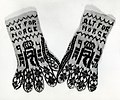
H7 was the royal cypher of the Norwegian head of state, King Haakon VII, who reigned from 1905 to 1957. When Germany invaded Norway in 1940 as a part of World War II, the royal family fled the country and Haakon VII later spearheaded the Norwegian resistance in exile in the United Kingdom. H7 became one of several symbols used by the Norwegian populace to mark solidarity with and loyalty to the King, and adherence to the Norwegian resistance movement.




